Preliminary study of a novel dental hand instrument for restorative procedures
J Dent Res Dent Clin Dent Prospects, 11(3), 195-199; DOI:10.15171/joddd.2017.035
Clinical Dentistry
Preliminary study of a novel dental hand instrument for
restorative procedures
Les Kalman1*, Allen Xian1
1
Schulich School of Medicine & Dentistry, Western University, London, ON, Canada
*Corresponding Author; Email: ljkalman@icloud.com
© 2017 by Tabriz University of Medical Sciences
Abstract
Background.There is no clear consensus on operative hand instrumentation. In general, there is one hand instrument that
completes one task. Consequently, numerous instruments are required for the placement, shaping and carving of a restoration.
This reduces clinical efficiency, increases cost and may generate frustration.
Methods. A novel dental hand instrument has been developed. The instrument (GTI) can complete several tasks. The instrument
was assessed in a laboratory setting with amalgam, composite and glass-ionomer restorations on dentoform teeth.
Results. Results indicated that class II amalgam and composite restorations were significantly faster than conventional instrumentation
(P<0.05). Differences in restoration quality were not statistically significant. Cost was significantly reduced
as the GTI could perform the task of 9 conventional instruments.
Conclusion. The GTI is an industry-translated, novel medical device that offers the clinician an alternative to standard
instrumentation. Further investigations are required with increased samples sizes, clinical assessment and expanded utility.
Keywords: Instrumentation, medical device, translational research
Introduction
The consensus on operative dentistry hand instrumentation for restorative procedures remains unclear and subjective with only general guidelines.1 Generally, one instrument will provide one function. The clinician determines which instrument to use for the specific task,2,3 and this information is typically acquired from their dental education.4 Consequently, numerous instruments are required for the predictable and successful placement, shaping and carving of dental restorations. The multi-instrumentation approach can impact clinical efficiency, causing increased procedural time.5 Additionally, the set-up, take-down and sterilization times may be negatively impacted. These factors may tend to reduce production and increase frustration for the clinician. Within an academic setting, the aspect of multi-instrumentation may lead to confusion, affecting the confidence and learning process of the dental student.6
The objective of this investigation was to develop a novel multi-use, cost-effective dental hand instrument that had the functionality of several hand instruments. The intent was to provide an alternative instrument to several other single task instruments. The prototype instrument, termed GTI, would hypothetically provide a higher quality and more efficient restoration, and could be rapidly translated to industry and market.
Methods
Design
The design of the prototype began by assessing the most commonly used hand instruments and their specific design. The GTI was drafted and the dimensions translated to working prototypes for assessment. Multiple iterations of the prototype followed, based on laboratory and clinical assessment and feedback. Once the design was finalized, the aspect of manufacturing was assessed. A manufacturer was sourced and the instrument design was mildly tweaked, based on production factors. The GTI (Figures 1, 2 and 3) was manufactured for evaluation through Zoll-Dental/Cislak Manufacturing Inc. (Niles, Illinois, USA).

Figure 1.GTI instrument: Full view.
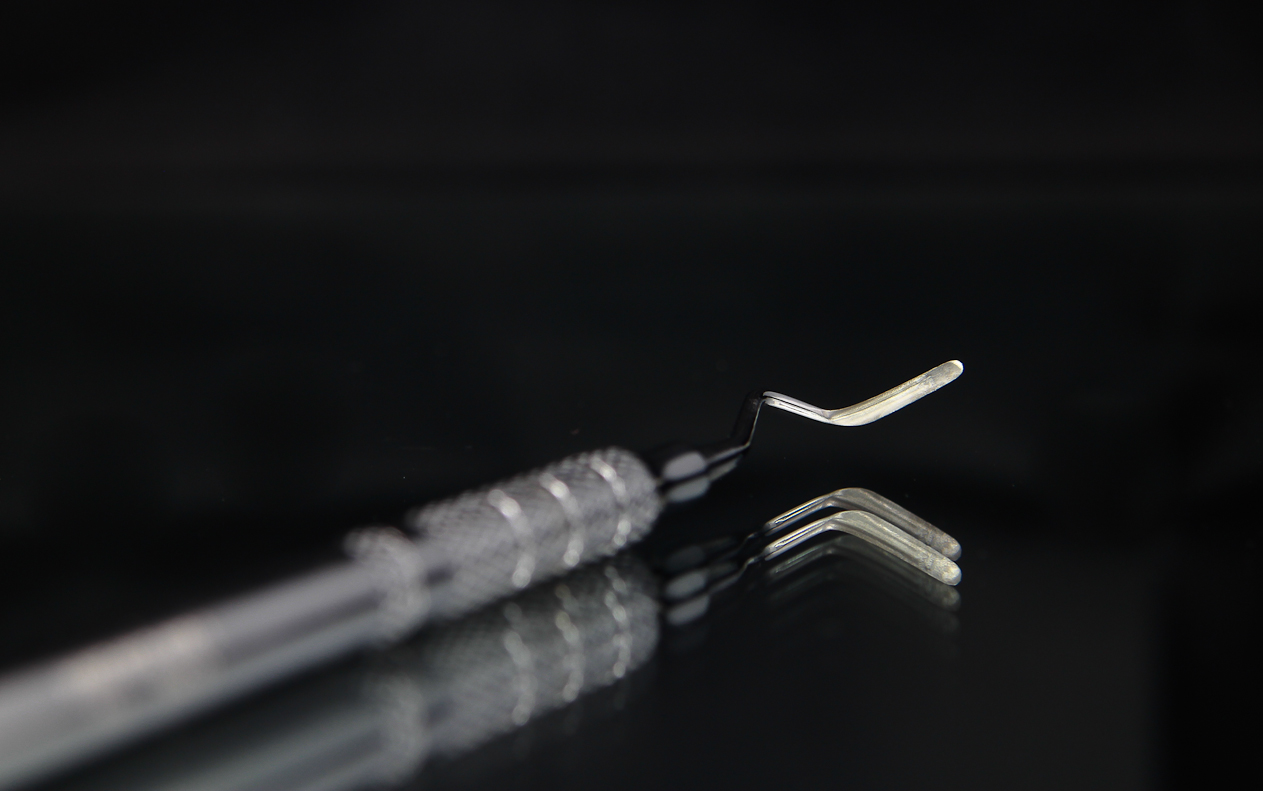
Figure 2. GT instrument: End view I.

Figure 3.GTI instrument: End view II.
The GTI combines several angulations to allow the clinician easy access to all areas of the tooth for placement, shaping and carving of all restorative materials. The blade has been designed with mild flex and unique cutting surfaces to facilitate the easy carving and removal of dental materials.
Assessment
The functionality of the GTI was assessed in a preliminary laboratory study using plastic dentoform teeth and three restorative materials: amalgam, composite and glass-ionomer. Procedural time and quality of the restoration were recorded.
Forty Class II mesio-occlusal or disto-occlusal and twenty buccal Class V preparations were drilled on mandibular first molar dentoform teeth. Ten amalgam (Permite, SDI: Itasca, Illinois) restorations were placed and carved using standard instrumentation (Figure 4) (Table 1). Ten amalgam restorations were placed and carved using the GTI (Figure 5). Ten composite (Filtek Supreme, 3M ESPE: Maplewood, Minnesota) restorations were placed and shaped using standard instrumentation. Ten composite restorations were placed and shaped using the GTI (Figure 6). Ten Fuji IX (GC America: Bongo, Japan) restorations were placed and shaped using standard instrumentation. Ten Fuji IX restorations were placed and shaped using the GTI (Figure 7. All preparations and restorations were completed by a first-year dental student. Total procedural time was recorded for each restoration.
|
Table 1. Standard instrumentation
|
|
Instrument
|
Code
|
Manufaturer
|
City, Country
|
|
Condenser
|
LLO/1NS6 |
Brasseler |
Ventura, USA |
|
Condenser
|
PL1/4PN6 |
Brasseler |
Ventura, USA |
|
Egg/Ball Bumisher
|
B27/296 |
Brasseler |
Ventura, USA |
|
Acorn Burnisher
|
B21B6 |
Brasseler |
Ventura, USA |
|
Tharp Carver
|
CVTH1 |
Hu-Friedy |
Chicago, USA |
|
Esthetic Carving Knife
|
CR21 |
Hu-Friedy |
Chicago, USA |
|
Gold Condenser
|
TINBRDILLY6 |
Brasseler |
Ventura, USA |
|
Hollenback Carver
|
CT36 |
Brasseler |
Ventura, USA |
|
Explorer
|
UNC156 |
Brasseler |
Ventura, USA |
|
Mini 3
|
CIGFT |
Hu-Friedy |
Chicago, USA |
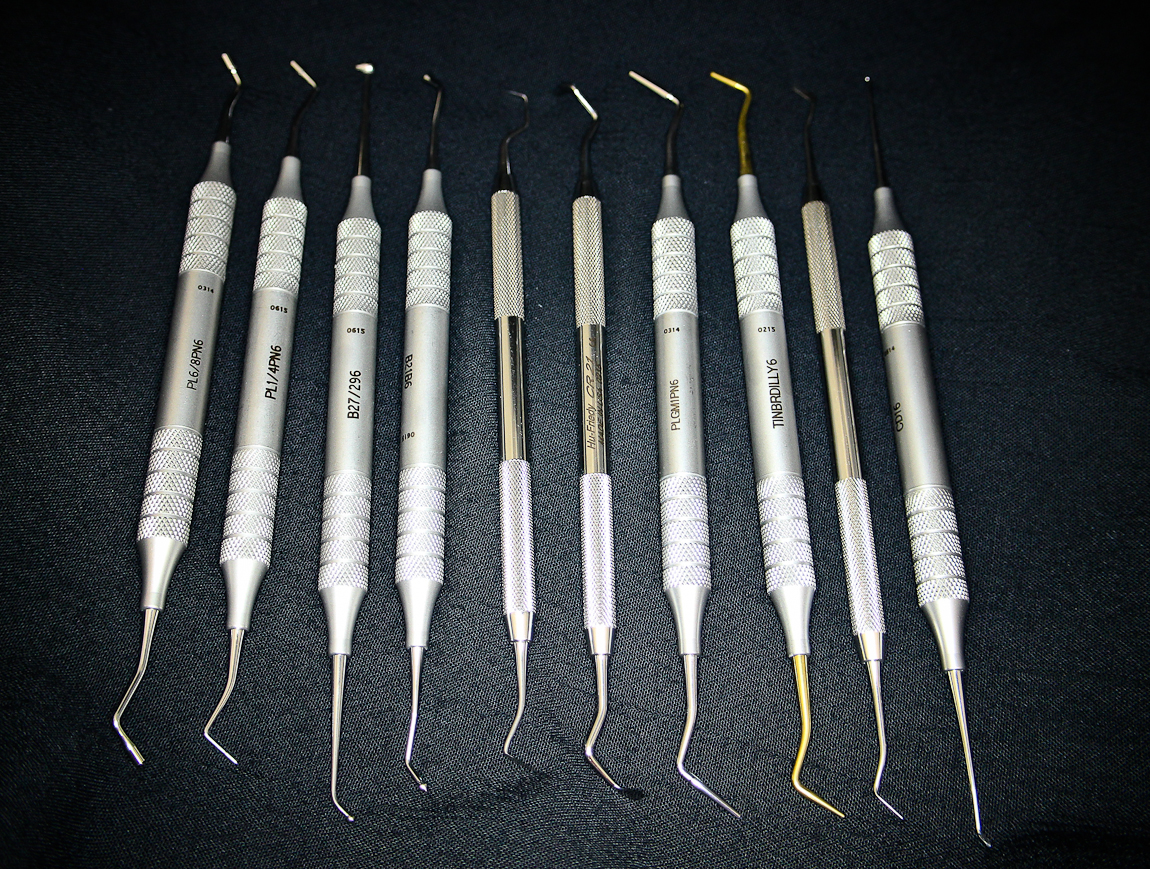
Figure 4.Standard instrumentation.
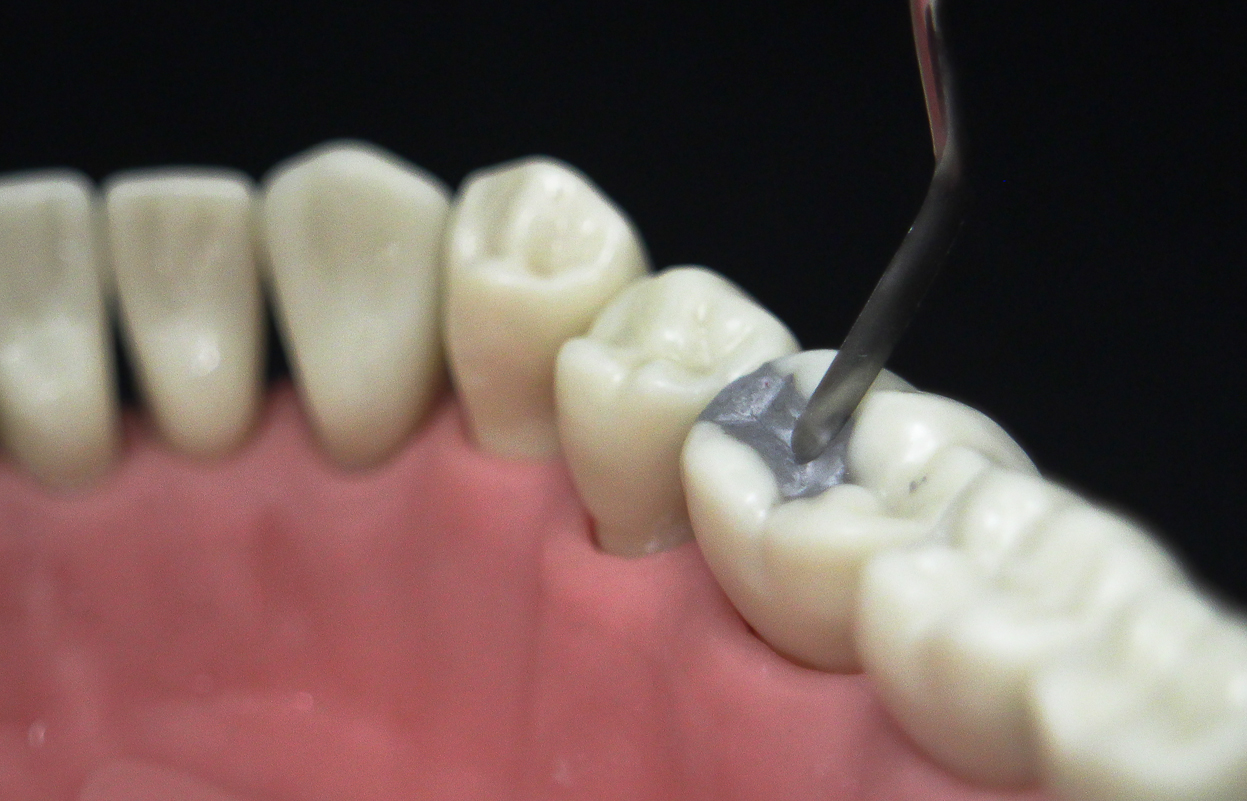
Figure 5.GTI: GTI/amalgam use.
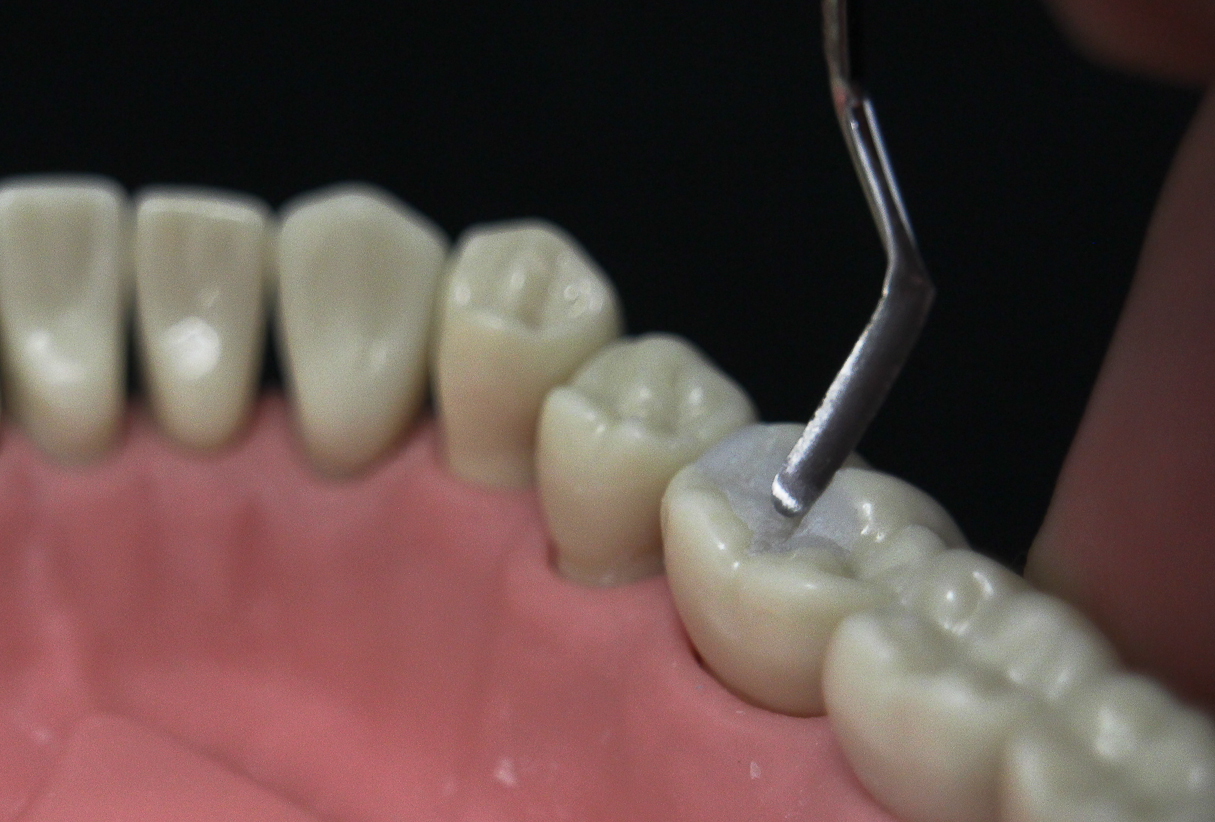
Figure 6.GTI: GTI/composite use.
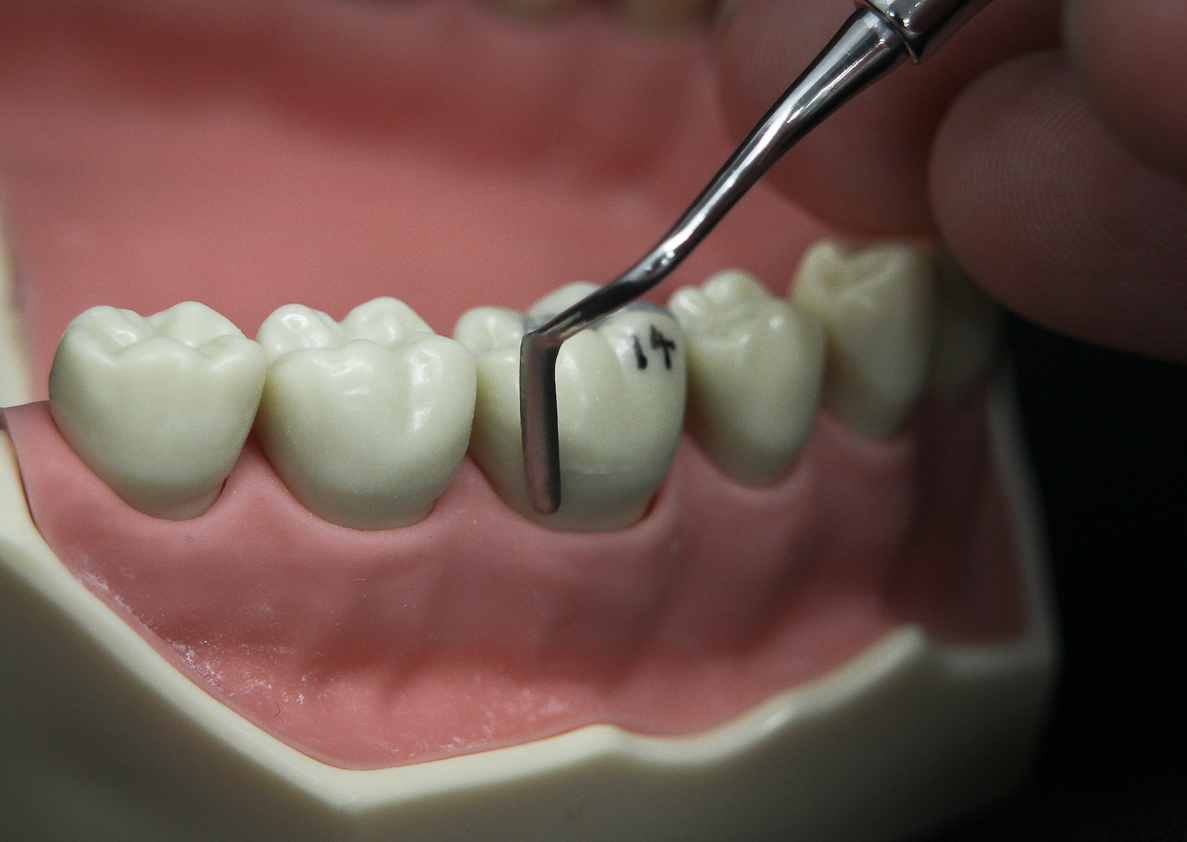
Figure 7.GTI: GTI/glass-ionomer use.
Restorations were blindly evaluated by a full-time faculty member using the pre-clinical evaluation criteria set forth by Schulich Dentistry. The evaluation criteria are the standard for grading pre-clinical restorations on dentoform teeth at the dental school at Western University (Appendix I). Scores were summed and averaged for each restoration (Table 2). Statistical analysis employed an unpaired t-test with a 95% confidence interval.
|
Table 2. Mean restoration times and scores
|
|
Group
|
Mean Restoration Time
|
Mean Restoration Score
|
|
Amalgam Standard Instrumentation
|
7.81 |
22.90 |
|
Amalgam Prototype Instrument
|
6.72 |
22.90 |
|
Composite Standard Instrumentation
|
32.76 |
23.20 |
|
Composite Prototype Instrumentation
|
29.61 |
23.10 |
|
Glass Ionomer Standard Instrumentation
|
3.92 |
11.10 |
|
Glass Ionomer Prototype Instrumentation
|
3.82 |
11.20 |
Results
Time
Class II amalgam and Class II composite restorations using the GTI instrument were significantly faster than restorations using standard instrumentation (*P<0.05). Class II amalgam and Class II composite restorations using the GTI instrument were completed on average 65 seconds and 189 seconds faster, respectively. Restoration times of Class V glass-ionomer restorations were not significantly different between the GTI instrument and standard instrumentation (Figure 8).
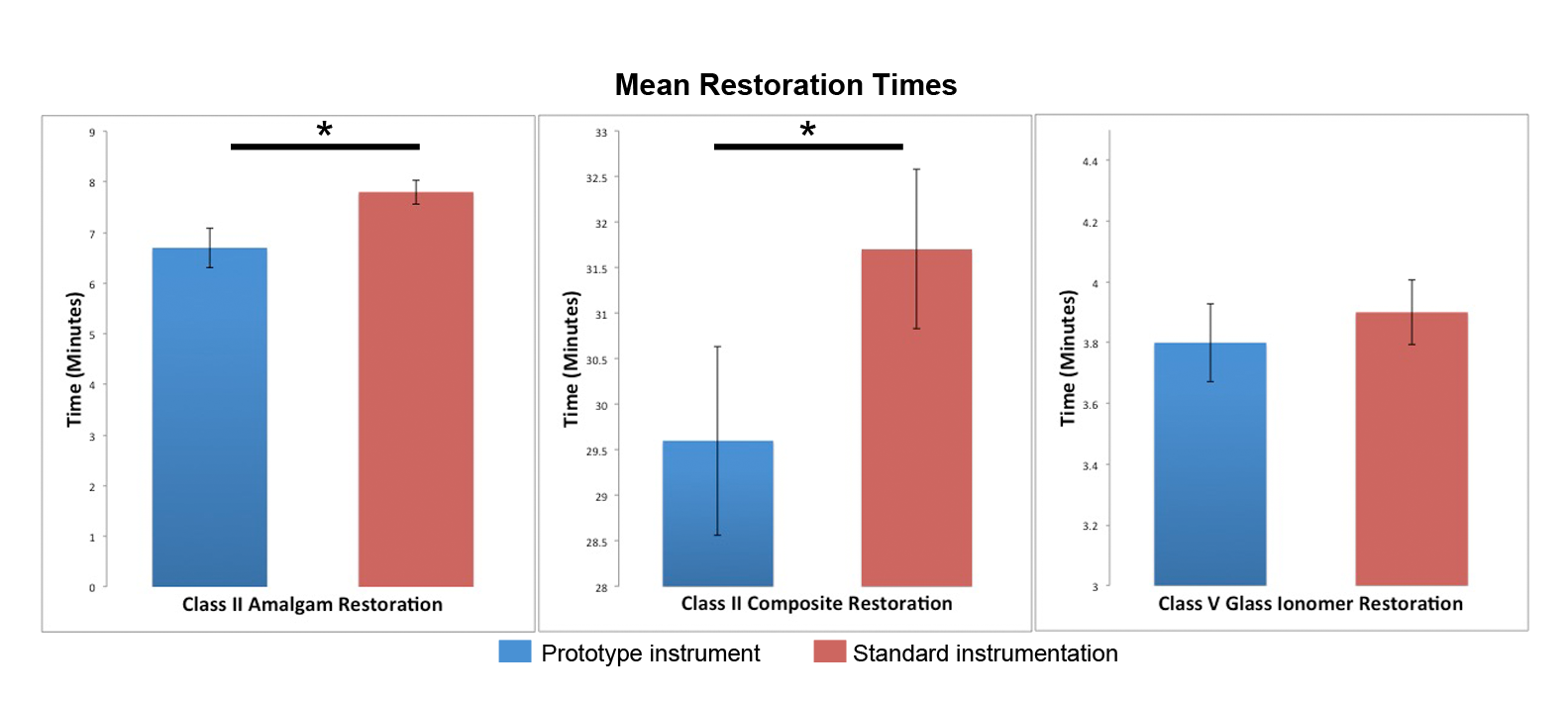
Figure 8.Mean restoration times
Quality
There were no significant differences in the quality of the restoration between the GTI instrument and standard instrumentation, for Class II amalgam, Class II composite, and Class V glass-ionomer restorations (Figure 9).
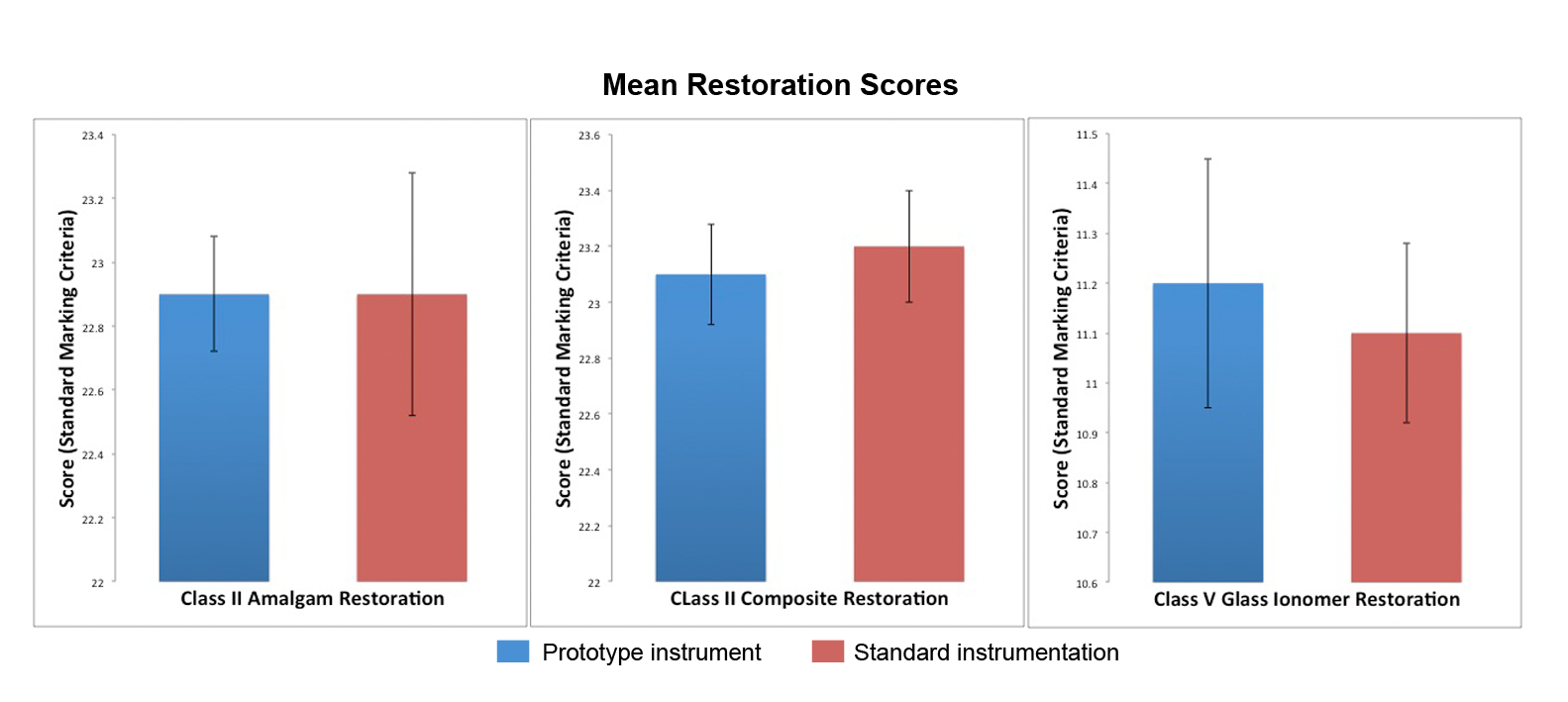
Figure 9.Mean restoration scores.
Discussion
The GTI was developed as an alternative to conventional instrumentation. The GTI provides the function of several other standard hand instruments, resulting in a significantly more efficient procedure. The GTI also represents a significant cost-effective alternative, as production and consumer costs for the instrument would be a fraction of the amount of standard instrumentation. The GTI did not provide a higher quality restoration, under these research conditions.
The investigative data represents a rather small data set. This was a direct factor to the available funding and research time. Further research would ideally consider a larger sample size with increased detail on times and scores. Additionally, times and cost could be analyzed with respect to set-up, take-down and cost of sterilization. The latter would be very interesting from an academic institution perspective.
This investigation represents research innovation with the intent of short-term industry translation. The GTI has been evaluated by industry (Clinician’s Choice, London, Canada) through market evaluation and independent clinical assessment. The GTI has been translated and will be available to clinicians. The GTI has a much broader functionality, with applications in prosthodontics, implantology and oral surgery. Further clinical research is required to substantiate the utility in other dental disciplines.
Conclusions
As clinicians, we aim for the most cost-effective and efficient manner to deliver the highest quality of dentistry. The GTI offers an alternative for the dentist. The GTI can replace several other hand instruments in the placement, shaping and carving of dental restorations. Additionally, by reducing the total number of instruments, overall office efficiency can be maximized with a reduction in operating costs. As the concern of economics and environmental awareness increases, the GTI represents a minute but significant step towards a leaner approach with the delivery of clinical dentistry.
Acknowledgments
This investigation was conducted at the Schulich School of Medicine & Dentistry at Western University and was supported by Schulich Dentistry Summer Student Research Program, Schulich Medicine & Dentistry, Dentistry Canada Fund (DCF): Ontario Dental Association Summer Research Studentship and Research Driven Inc. The GTI is available through Research Driven Inc. (http://researchdriveninc.com) and will be available through Clinician’s Choice.
Authors’ contributions
LK was the principal investigator, developed the instrument, developed the research plan, reviewed and edited drafts, created final version, and submitted the manuscript. AX is a dental student, and performed research and wrote manuscript drafts. Both authors have read and approved the final manuscript.
Competing interests
An author has a financial affiliation with the subject material. Dr. Kalman is the inventor and developer of the instrument and President of Research Driven, a corporation that owns the intellectual property.
Funding
Funding provided by the Schulich Dentistry Summer Research Program & Research Driven Incorporated.
Ethics approval
None required.
References
- Sturdevant CM, Roberson TM, Heymann HO, Sturdevant JR. The Art and Science of Operative Dentistry. 3 edn, 468 (Mosby, 1995).
- 2. Dentist training manual for military dentists, Chapter 4, Operative Dentistry. Vol. 2 90 (Integrated Publishing).
- Evans TE, Lucaccini LF, Hazell JW, Lucas RJ. Evaluation of Dental Hand Instruments. Hum Factors 1973;15:401-6. doi: 0.1177/001872087301500411 (). [Crossref]
- Siegel SC, von Fraunhofer JA. Dental burs--what bur for which application? A survey of dental schools. J Prosthodont 1999;8:258-263.
- Finkbeiner BL. Four-handed dentistry revisited. J Contemp Dent Pract 2000;1:74-86.
- Henzi D, Davis E, Jasinevicius R, Hendricson W, Cintron L, Isaacs M. Appraisal of the dental school learning environment: the students' view. J Dent Educ 2005;69:1137-47.